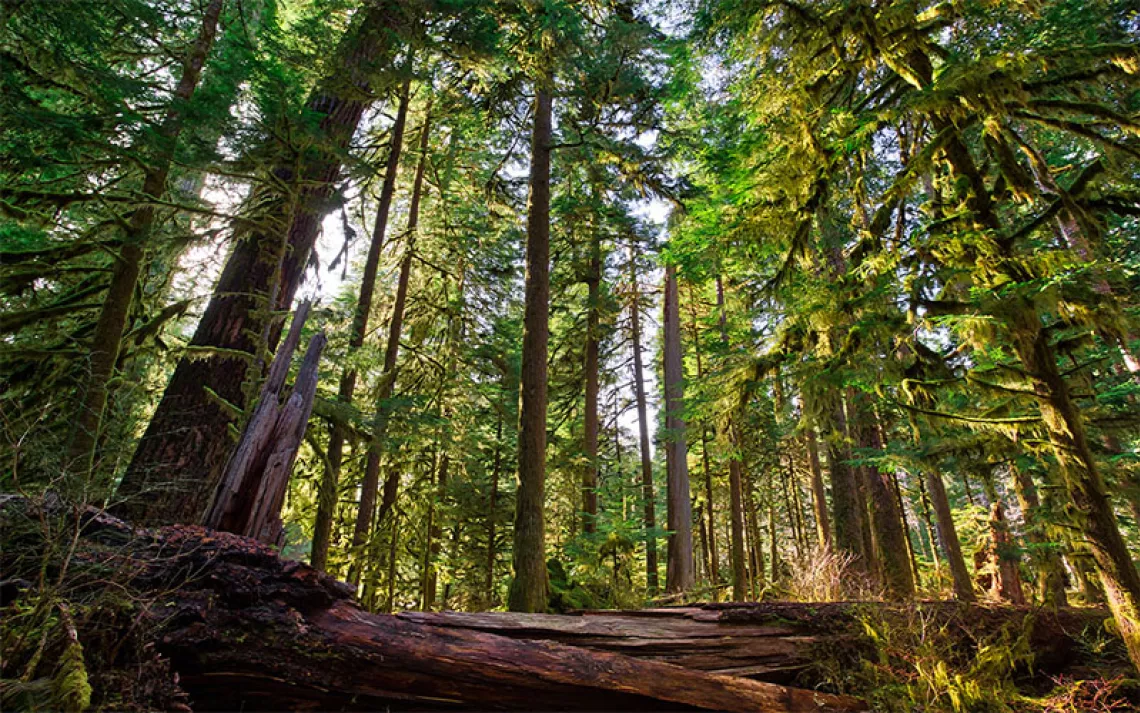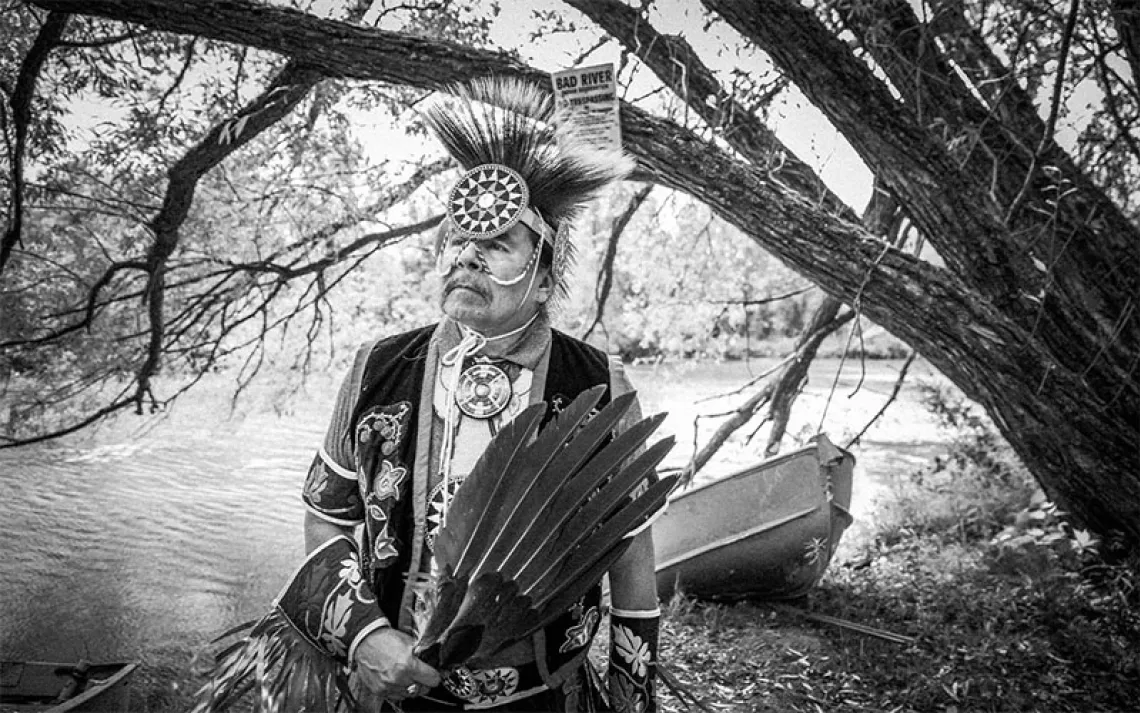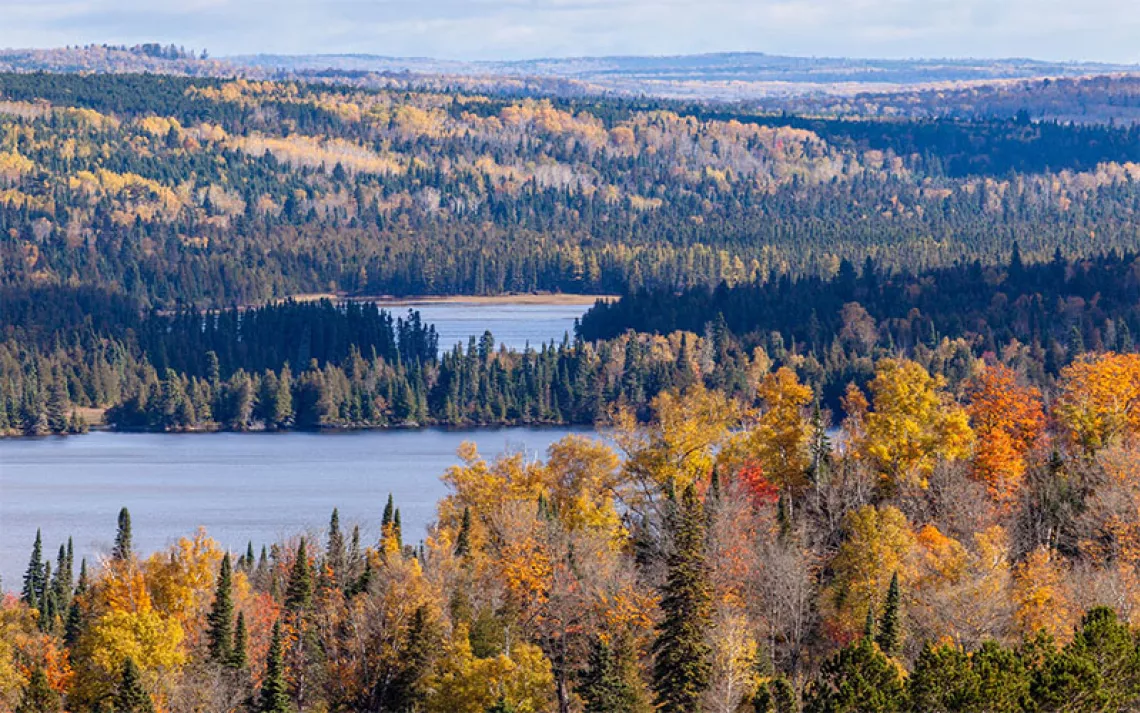The Land Back Movement Unravels Manifest Destiny
Across Indian Country, tribal nations are buying back their land one parcel at a time
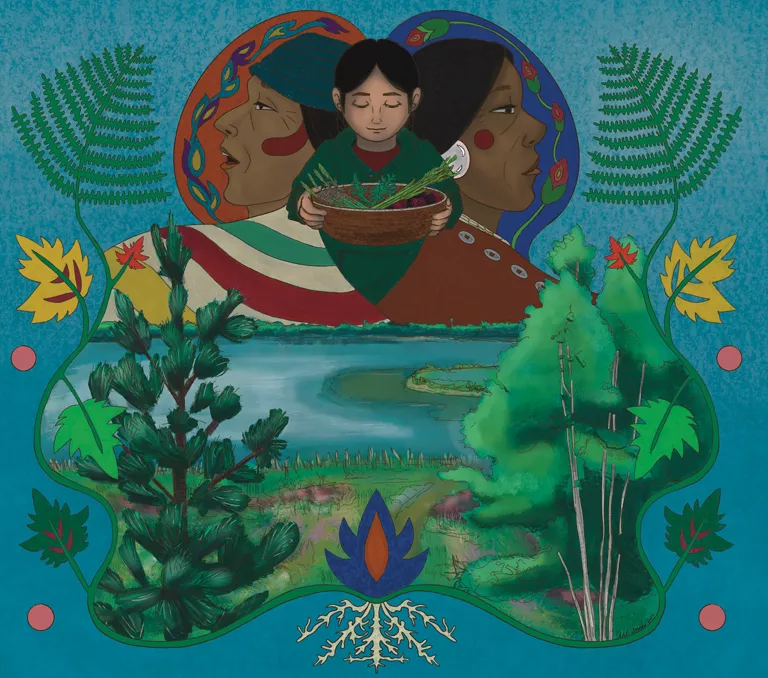
IN JUNE 2022, the Bois Forte Band of Chippewa nearly doubled the amount of land owned by the tribe. The Bois Forte's 3,600 enrolled members live in the northernmost reaches of Minnesota, amid a sprawling forest of aspen, birch, maple, and jack pine (bois forte is French for "strong wood"). The tribe's reservation includes three separate areas—Nett Lake, Vermilion, and Deer Creek. Most members live in Nett Lake, where the sapphire waters of the North Woods sustain some of the country's densest stands of wild rice, the Chippewa's sacred food.
As in many Native American reservations, the acreage within the Bois Forte's official boundaries is a mix of tribal lands, state lands, and non-Native private holdings. Across the United States, more than half the land within reservation boundaries is controlled by non-Indians—the result of 19th-century federal laws that allowed white settlers and corporations to snatch up reservation lands during western expansion. This is true for the Bois Forte Band of Chippewa, which owns less than half the area within the three sections of its reservation. The summer land sale was a major step in addressing that imbalance.
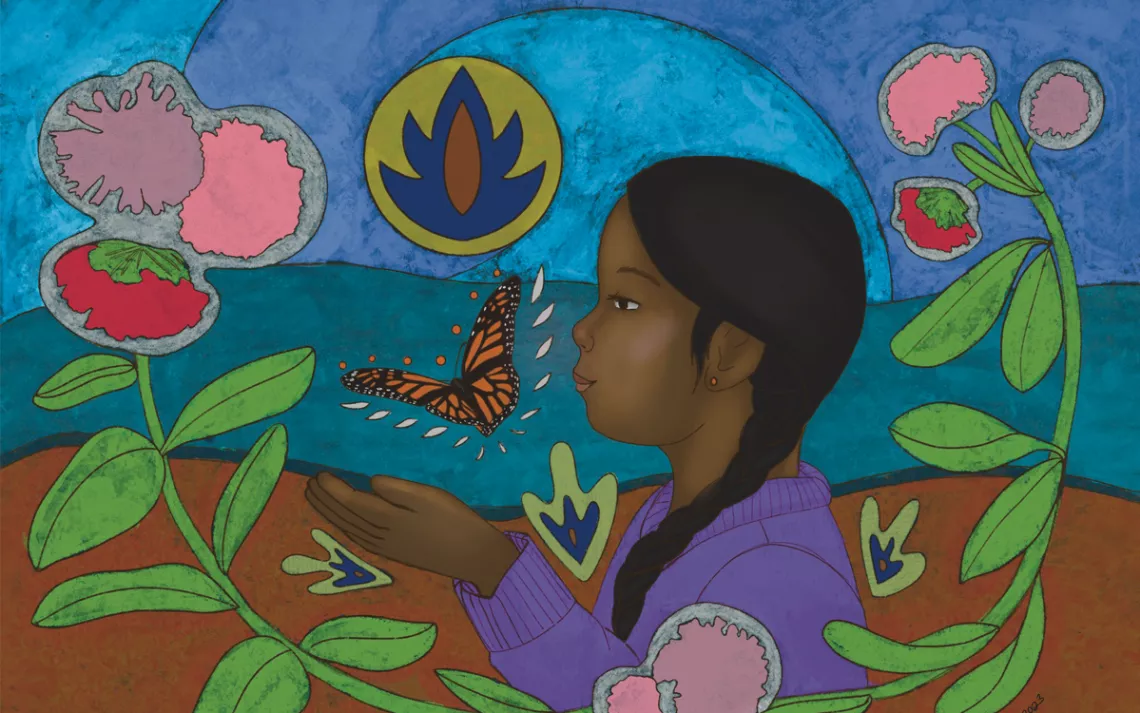
"As you can tell, with the Bois Forte here in Nett Lake, we don't own a lot of our land in our reservation boundaries," tribal chair Cathy Chavers told me as she pored over a large, outstretched map of the band's territories. I was in the tribe's drum-shaped government building—the lake waters sparkled outside the conference room window—watching Chavers and tribal staff review the recent land acquisitions. All the reclaimed acreage had once belonged to the tribe and its members, as established by two treaties that the Bois Forte Chippewa and the US government agreed to in the 1850s and 1860s. Then the US Congress passed the General Allotment Act of 1887, which divided and distributed reservation lands to tribal individuals and opened up the remaining "surplus" lands for purchase by non-Natives and corporations. And that's how the checkerboard of ownership happened and the jumble of different jurisdictions led to tension between tribal members and non-Natives living or working on reservation territory.
Chavers and the other tribal officials were feeling triumphant when I visited just a few months after the land sale was completed. The agreement had returned 28,089 acres to tribal control, but it had required a twisting, years-long effort to seal the deal. In 2016, PotlatchDeltic, a logging corporation, approached Bois Forte officials with an offer to sell its forestlands within the reservation. With an asking price of $1,000 per acre, however, the $28 million offer was simply too high for the tribe to afford, even with its profitable casino business. So the tribal council came up with a plan B: Buy back the acreage parcel by parcel over decades.
If tribes wish to finally make good on the decades of earlier advocacy, it will require developing a new justice framework for Indian land claims.
Then, in 2020, a new opportunity popped up. The Conservation Fund—a land trust that protects wildlands and agricultural lands in all 50 states—reached an agreement with PotlatchDeltic to purchase 72,000 acres of its holdings, including the lands historically belonging to the Bois Forte Chippewa. The Conservation Fund's Minnesota director, Kim Berns-Melhus, reached out to an organization called the Indian Land Tenure Foundation, which offers small grants and helps connect tribes with loan opportunities for Native land acquisitions. "We've got this land," Berns-Melhus told the staff at ILTF. "It really should be the band's land. Are you willing to work with us to try and get this done?"
Cris Stainbrook, president of the ILTF, who is of Lakota descent, is often hesitant when he gets such calls. Although some tribal nations have agreed to land transfers with various preconditions—like conservation easements that bar development or allow public access—many others are wary of land deals brokered by conservation groups, since they have strings attached and can fall short of true ownership and autonomy. "Our view of it is, unless the tribes own it, [the land] is always at risk of being damaged or destroyed or utilized in an inappropriate fashion," said Stainbrook, who is a self-described tribal sovereignty "hardliner." "There are some conservation groups we won't work with because they oftentimes target lands that the tribes want, but they've got all these wealthy backers, and so they can go in and buy it. Then what they do is they sell conservation easements on that land and then they turn around and ask the tribe if they want it."
The land is intertwined with personal and family histories, collective tribal identity, and cultural survival.
That wasn't the case this time, so Stainbrook helped broker a deal in which the Bois Forte Chippewa would borrow money from his organization to buy the land from the Conservation Fund. Because PotlatchDeltic had enrolled its parcels in Minnesota's sustainable forestry program, the band would earn money for not cutting down trees—money it could then use to pay off its loans. "When the Conservation Fund got [the land], it didn't deal with any federal legislation," Chavers said. "We didn't have to go to Congress. We didn't have to go to the Bureau of Indian Affairs."
The Bois Forte Chippewa's successful land recovery was one of the largest returns of tribal lands that has occurred in US history without an act of Congress. But it was exceptional only in size.
More than ever before, tribes are recovering their lands after centuries of violent land lust. By my count, in the past two decades there have been at least 100 tribal land recoveries involving some 73 state or federally recognized tribes, an intertribal coalition, and six Indigenous-owned land trusts. Altogether, these recoveries have secured over 420,000 acres for Native peoples. Indian lands have been recovered through a variety of means: outright land title purchases, donations from private landowners, transfers from land conservancies, and federal and state legislation, including long-overdue recognition of tribes that didn't have legal status.
In Virginia, the Rappahannock Tribe, which gained federal recognition in 2018, has received about 465 acres, donated by the Chesapeake Conservancy. Similarly, the Save the Redwoods League in California donated 523 acres of forested land to the Intertribal Sinkyone Wilderness Council, a Native land trust that includes 12 tribes. A few hours to the southeast of Nett Lake, Bois Forte's sister band, the Fond du Lac Band of Lake Superior Chippewa, has recovered over 1,500 acres in the past few years by purchasing non-Indian-owned, tax-forfeited lands in its reservation. The Fond du Lac Chippewa tribe has turned hundreds of acres of forest and wetland into carbon-credit projects, an enterprise strategy that the Bois Forte Chippewa is planning to emulate.
Each of those territorial recoveries is part of a larger movement captured by two words: Land Back. Part activist campaign, part culture-jamming meme, part restorative justice effort, Land Back has become a central element of Indigenous politics in recent years. But a slogan is one thing; actual success on the ground is something else entirely. As the experience of the Bois Forte Chippewa reveals, recovering land is no easy feat. Tribes are often burdened with a lack of capital, exorbitant land costs, and the whims of a seller's market. They may face local or regional opposition from neighboring non-Native governments, special interest groups, or land owners.
Perhaps the biggest obstacle to Land Back is the law itself. For more than two centuries, federal law has been structured, and honed, to expropriate Indigenous land title and to make it difficult, if not impossible, for Indians to control what was once all theirs.
ACROSS INDIAN COUNTRY, Land Back is imbued with various cultural, spiritual, and political meanings. It's hashtagged like graffiti throughout Native Twitter and inscribed on signs and banners at Indigenous-led demonstrations. Land Back has become a catchall demand: adopted by water protectors fighting oil and gas pipelines and embraced by Native activists seeking to reassert Indigenous sovereignty. Nick Tilsen, an Oglala Lakota who is president of the NDN Collective, an Indigenous group spearheading the Land Back movement, has called it "a war cry for the liberation of Indigenous people."
The idea has even infiltrated pop culture. In a cold open to an episode of Reservation Dogs—an FX Networks series written, directed, and produced by Native talent—an elderly white couple discuss what Land Back could possibly mean when they see it spray-painted over a highway welcome sign for Okern, Oklahoma. "They want the whole damn thing back?" the man asks. "Well, I suppose so," the woman says. "Some of it back, maybe," the man wonders aloud. "But all of it?"
The answer depends on whom you ask. The NDN Collective argues for returning all federal public lands—some 640 million acres—to the continent's original caretakers. In a much-discussed 2021 cover story for The Atlantic, David Treuer, an Ojibwe writer and historian, called for transferring the national parks to tribal control. "For Native Americans," he wrote, "there can be no better remedy for the theft of land than land."
But Land Back is more than a vast real estate transfer scheme. Returning land—whether public or private—to the tribes is a way of making reparations for centuries of dispossession. Tilsen told me, "Land Back for sure is about the physical return of the land, but it's also about dismantling the systems that made it possible for the diluting of our land in the first place." For Native peoples, land is not just acreage, nor simply the foundation of tribal sovereignty under federal law. The land is also inextricably intertwined with personal and family histories, collective tribal identity, and cultural survival. Possession is, famously, nine-tenths of the law; for Native Americans, it could be said that possession of land is ten-tenths of cultural well-being. The centuries-long seizure of Indian territories has always been the spearpoint of genocide.
To understand the contrived process of Indigenous land recovery, it's crucial to understand how, exactly, those lands were lost. To be able to glimpse the road ahead for Indian land justice, one has to first understand how the dispossession took place, bit by bit.
The dark heart of US-Indian relations is a 15th-century idea known as the Doctrine of Discovery. Promulgated by a series of papal decrees in the 1400s, the doctrine was used by European Christian colonists to justify the global takeover of non-Christian lands. Earlier this year, Pope Francis formally repudiated the doctrine, but it nevertheless remains a foundation of US law.
In 1823, the US Supreme Court ruled in Johnson v. McIntosh that European settlers had preemptive rights to territories they claimed to have discovered. Basing its decision on the Doctrine of Discovery, the court ruled that while Indigenous peoples had a "right to occupancy," white settlers enjoyed a much more expansive "right to dominion." Eventually, the decision in McIntosh would allow for "aboriginal land titles" to be easily overwritten through territorial purchases made by the US government, and for Native land rights to be simply ignored via unratified treaties with Indian nations and the ubiquitous violence by westward settlers. (Of the 375 treaties negotiated between Indian nations and colonies, states, and the federal government, nearly 200 were left unratified.) Under McIntosh, US-Indian treaties would become a major tool for extinguishing Indian title and solidifying settler claims to the continent.
John Marshall, then chief justice, admitted that a doctrine that sought to justify the conquest of an already inhabited country was an "extravagant pretension." But the self-serving ruling nevertheless gave a thin legal cover to a process that had been underway since the Puritans began occupying the lands of the Wampanoag, the Pequot, and the Massachuset two centuries earlier. Even before the US Constitution was established, state governments were erasing hundreds of millions of acres of aboriginal land titles through treaty-making and genocidal warfare. State governments, and eventually the federal government, greased the land-market wheels, effectively ensuring that the white-settler cast of speculators, corporations, politicos, military personnel and militiamen, missionaries, miners, and homesteaders could keep expanding their holdings to attain continental supremacy.
Native nations, though, still held on to significant chunks of land—especially in the Indian Territory of Oklahoma and in the Far West. By the late 1880s, tribes collectively controlled 138 million acres. But the white settlers were ascendant. The Lakota Wars were over and Crazy Horse assassinated; the Apache leader Geronimo had surrendered and was in prison in Florida. In 1887, Congress passed the General Allotment Act (often called the Dawes Act) in an effort to offload federal responsibility for Indian welfare and hasten assimilation. The law distributed, or "allotted," collectively held reservation lands to individual Indians. Any undistributed lands were eventually offered for sale to settler homesteaders and corporate interests such as timber and mining companies.
The Dawes Act wasn't merely a land grab; it was an assimilation tool for what today we'd call cultural genocide. The thinking went that by alienating and atomizing Indigenous peoples from collectively holding their lands, tribes would become dislocated from their traditions, ceremonies, languages, and customs. This would make Native communities more susceptible to Christian indoctrination—another form of the "kill the Indian in him, save the man" policy of assimilation that Indian boarding schools were infamous for. In his book Custer Died for Your Sins, preeminent Standing Rock Sioux scholar Vine Deloria Jr. called the Dawes Act "a race between the stealers of men's land and the stealers of men's souls."
The policy was catastrophic for Native Americans. In total, the Dawes Act extricated 90 million acres from Indian reservations, leaving tribes with less than 48 million acres. The allotment era also led to another vast, nearly omnipresent problem: Indian land "fractionation" through state probate law. When allotments were distributed to individual Indians, each heir of those original land recipients received an equal interest of the initial allotment, creating an unmanageable ownership structure. If an Indian "allottee" wants to lease their land, they need agreement from a majority of all the associated Indian landowners. The fractions of ownership have gotten smaller with each generation (think .0000001 interest) as the number of owners has kept growing. Today, some lands have hundreds, even thousands of these "fractionated" interests within a single allotment. One 80-acre parcel on the Lac Courte Oreilles Band of Lake Superior Ojibwe reservation in Wisconsin had 2,285 owners.
To stop tribal nations from bleeding land, Congress in 1934 reversed course and passed the Indian Reorganization Act, which ended the allotment era. The centerpiece of the new law was a system by which tribes could put their lands in trusts managed by the Bureau of Indian Affairs. Today, according to the BIA, about 56 million acres of land are held in trust for tribal beneficial use—or roughly 9 percent of reservation lands recovered since the Dawes Act. An additional 10 million acres of individually owned Indian allotment lands are held in trust, the BIA reports.
Yet the BIA's official count of Indian lands is badly out of date. "It's just amazing," said David Bartecchi, director of the Native Lands Advocacy Project. "There's no regular reporting on Native land area totals, and so it is very hard to track. Are Native lands increasing? Are they decreasing? Are trust lands increasing, and what's going on with fee lands? There's the notion that fee patenting stopped with the Indian Reorganization Act, but clearly it didn't. I mean, it continued all the way up to today."
In 2014, the ILTF began contacting tribes to request their tribal land data in an effort to fully understand the situation in Indian Country. "For basically three years, we had the most up-to-date numbers on that. When we did it, we made sure the tribes knew that we weren't going to share it with anyone, and they were willing to give it to us," Stainbrook said. "And two or three years later, we got a call from the secretary of the interior's office. They wanted to know if they could have our database." He paused to laugh. "And it was one of those sweet irony things where you go, 'Well, we'd like to give it to you, but we have to ask the tribes' permission first.'"
Beyond the Land Back movement, generations of Indian scholars, lawyers, activists, warriors, and matriarchs have dedicated their lives to Indian rights and land recovery. If tribes wish to finally make good on the decades of earlier advocacy, it will require developing a new justice framework for Indian land claims. Most of all, that will mean fixing the broken and unbalanced nation-to-nation relationship that has for so long permitted tribal dispossession.
Years ago, Deloria Jr. described this as an Indigenous "recolonization," a homecoming that will involve "a revival of Indian social and legal patterns." Put another way, Land Back is nothing less than the reversal of Manifest Destiny.
CRIS STAINBROOK HAS a gentle, lighthearted demeanor. When explaining the details of federal Indian law, he often snickers, an ironic laugh that seems to help him get through the law's unnerving cynicism and unabashed paternalism toward Native nations. His work at the Indian Land Tenure Foundation mostly involves the unglamorous, excruciatingly bureaucratic machinations of securing Indian land ownership: real estate deals, fee-to-trust title transfers, financing and loans, and dealing with heavily fractionated lands. "Sometimes I give these talks to the public, and they say, 'Well, some of this is quite a long time ago, and how are you ever going to solve that?'" he told me. "Well, it'd be one thing if it ended tomorrow." He laughed. "It still goes on, the taking of Indian land."
For much of the past 20 years, a good portion of Stainbrook's work has focused on helping Natives with allotted lands plan their estate or participate in a federal land buyback program designed to remedy the gargantuan land title fractionation problem. The buyback program was the result of a class action lawsuit—Cobell v. Salazar, settled in 2010—that addressed a century-long pattern of gross negligence and mismanagement of Indian trust assets. The lead plaintiff in the case was Elouise Cobell, a member of the Blackfoot Nation who before her passing in 2011 had spent her life advocating for Indigenous self-reliance and who had founded the first Native American–owned bank. "We never asked for this system—it was imposed on us," she told the Los Angeles Times in 1996. "Now, they [the federal government] are mismanaging our money—not appropriations or donations but our own money—and we can't fire them."
The settlement gave some of that money back by establishing a $2 billion fund to purchase fractionated Indian trust lands from individual Native landowners and transfer the properties to tribal governments. Many tribes across the United States benefited from the program, which ultimately purchased more than 1 million fractionated land interests across 36 reservations. In Minnesota, the Fond du Lac Band of Lake Superior Chippewa consolidated 4,248 acres through the settlement funds, while the Bois Forte Band of Chippewa accrued 2,815 acres.
But the program, which expired last November, was in many ways a disappointment. A couple of billion dollars may sound like a lot, but US real estate is expensive, and it was a rather paltry sum of money compared with the $150 billion allegedly withheld from tribes since 1880. Before she passed, Cobell would joke with Stainbrook that the buyback program could blow its whole budget in a single afternoon in California. "Usually, financial assistance from the Feds is nothing," said Tim Krohn, who is the information manager for the Fond du Lac Chippewa (but not a member of the band).
Also, like many federal programs, the buyback program was painfully bureaucratic. "Dealing with the federal government is always more complicated than dealing with the rest of the world," Krohn said. Chavers, the chair of the Bois Forte Chippewa, had graver words. "We are the most regulated people on this earth," she told me. "I mean, there are so many hurdles, there are so many barriers, that it's a wonder we can get anything done."
Among Native leaders involved in land recovery, the sharpest complaint about the buyback program is that it didn't fix the fractionation and inheritance problem across 574 tribes. Now that the program is gone, Indian landowners are left to consolidate their undivided interests themselves, while the federal government's current and available Indian land programs, like the Bureau of Indian Affairs' fee-to-trust acquisition program and the USDA's federal land acquisition loans for tribes, are limited and slow-moving.
The way Indigenous scholars see it, the core challenge confronting the Land Back movement is that federal law is not designed to restore Indian lands—but rather to usurp them. The United States' claimed plenary power over Native nations contains the peril of complete liquidation not only of tribal lands but also of tribal nations themselves. This is no idle threat. It's exactly what happened in the 1950s and 1960s, as the federal government revoked its recognition of more than 100 tribes during what's known as the Termination Era. For Land Back to succeed at any scale, Native thinkers argue, it will require asserting a new framework for Indian justice.
"Plenary is an anti-democratic concept which means absolute power," David Wilkins, a professor at the University of Richmond in Virginia and a member of the Lumbee Nation in North Carolina, told me. "In a democracy, there's no such concept as absolute power. The United States is a limited government, but since 1880, Congress has claimed and acted as if they could do anything [toward Native peoples]."
In his book Hollow Justice: A History of Indigenous Claims in the United States, Wilkins emphasizes a little-used strategy for securing Indian lands: Just go around the federal government, which has proved itself to be no friend to Indians. Wilkins points to four decades of lawsuits filed by tribes, many in the East, that alleged the states illegally purchased lands from Indigenous tribes without federal involvement, violating the Trade and Intercourse Act of 1790, which sought to protect Indians from "crime" and "trespass." Those suits ultimately led to the Maine Indian Claims Settlement Act, the Rhode Island Indian Claims Settlement Act, and the Massachusetts Indian Land Claims Settlement Act. Those state laws facilitated the return of tribal lands and also led to the federal recognition of some tribes that had lacked it before.
"There you had tribal nations drawing on a very old law and threatening states with lawsuits," Wilkins said. "The bottom line? It's going to take a concerted effort by many parties working together and doing the hard and deep research necessary to identify what was taken, how it was taken, and what are the steps necessary to have that, or at least some of it, returned."
Of course, such work takes time and money. Meanwhile, tribes are having some measure of success by entering into agreements with the federal government to comanage public lands.
Tribal comanagement of federal public lands and Land Back are often spoken of in the same breath. Although the current arrangements fall short of the sweeping land return imagined by Treuer in his Atlantic essay, they still represent progress toward justice. Last year, the US Forest Service finalized agreements with 13 tribes to establish what it calls "co-stewardship" within Tongass National Forest, Sequoia National Forest, and Umpqua National Forest, among other federal sites. The restored Bears Ears National Monument in Utah has a tribal comanagement system, as does the new Avi Kwa Ame National Monument in Nevada.
Kevin Washburn, dean of the University of Iowa College of Law and a member of the Chickasaw Nation, last year testified to a congressional committee about the comanagement arrangements and argued that they are a good start and should eventually be expanded. He said tribes should take on some of the duties now held by federal agencies—including fire management, surveys, planning, and water management—and that such a move would provide meaningful economic opportunities for the tribes. At the same time, he recognizes that the comanagement agreements have their limits. "I think it assists tribal sovereignty, it engages and takes advantage of tribal sovereignty, but it doesn't necessarily dramatically expand tribal sovereignty," Washburn told me. "It's just sort of using tribal governmental powers and resources to do the same thing that the federal government has an obligation to do."
Stainbrook is more skeptical. Tribes may have more input than they once did in the management of some federal lands, but ultimately they are just fulfilling a contract. There's no real shared decision-making over the stewardship of lands and waters, he said, nor is comanagement equivalent to tribal governance. "There's no way that it's equal power," he said.
For Stainbrook, power means ownership. As an example, he pointed to the role the ILTF played in securing Pe' Sla, a site in the Black Hills of South Dakota that is held sacred by the Lakota and Cheyenne nations. "Our biggest focus really is on beyond-reservation lands," Stainbrook said, where cultural sites are most at risk.
Returning land is, and always has been, the point. It all comes back to the foundation's slogan: "Indian lands in Indian hands."
A CURIOUS PAINTING hangs in the St. Paul offices of the Indian Land Tenure Foundation. In style and composition, it's strikingly similar to an 1872 oil painting titled American Progress, created by Brooklyn artist John Gast. Once widely reproduced, including in high school US history textbooks, American Progress is a pictorial allegory of the European American conquest of the continent.
On the left in Gast's painting, herds of bison and Indians on horseback flee westward under the shadow of storm clouds. Behind them come covered wagons, miners, homesteaders, and a railroad canopied with telegraph wires. Lady Liberty floats angelically above the scene. It's painterly propaganda in service to the foundational myth of the United States. In Gast's fantasy, there is no violence involved in westward expansion—no massacres of women and children, no land grabs, no reservations. The Anglo settlers' march toward the Pacific is inevitable, divinely ordained even.
The painting in the ILTF headquarters is a reverse image of the Gast original, and it offers a different notion of progress, this one grounded in justice for Indigenous peoples. A herd of buffalo rush the plains in a cloud of dust. Indian warriors charge eastward. Arrayed before them are some of the signature features of extractive colonialism: smokestacks, pipelines. A Native woman floats in the air, unraveling telegraph lines. The painting is titled Reversing Manifest Destiny.
Reversing Manifest Destiny was painted by a Sokaogon Chippewa artist, Charles Hilliard, after receiving a commission from Stainbrook. The foundation has turned it into posters and postcards that it uses for fundraising, and recently the Historical Society of New Mexico asked to reproduce it for an upcoming exhibit. Stainbrook said the painting never fails to resonate with people who come to the foundation's offices.
I can understand why. The artwork perfectly captures the hopes of many Native peoples: the dream of recovering and controlling their rightful homelands. Reversing Manifest Destiny defies the doctrine of seizure that the pope and the Supreme Court attempted to bestow. But the roughly 500 years of European conquest of the Americas will require generations to repair. As Stainbrook pointed out, simply resecuring the 90 million acres taken from tribes by the Allotment Act is "more than enough [work] for one lifetime." To claw back some portion of the 640 million acres of federal public lands will take even longer.
Thanks to the Land Back movement, though, Indigenous peoples are weaving their own destiny. Lands once torn at the seams are being mended by the tribes via a patchwork of efforts. Manifest Destiny is unraveling as a vision of Indian justice unfolds.
 The Magazine of The Sierra Club
The Magazine of The Sierra Club

